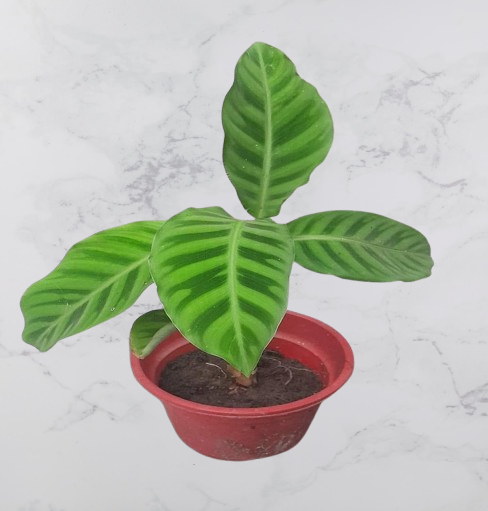Jui (Jasmine) plant known scientifically as Jasminum auriculatum, also called “Jui” in Bengali. It is a flowering plant from the family Oleaceae, and it is widely known for its aromatic flowers. Jasmine is a popular ornamental plant and has cultural and medicinal significance in many parts of the world.
1. Botanical Classification of Jui (Jasmine)
| Category | Details |
|---|---|
| Common Name | Jui (Jasmine) |
| Scientific Name | Jasminum auriculatum |
| Family | Oleaceae |
| Order | Lamiales |
| Origin | Tropical and warm temperate regions |
| Type | Shrub or climbing vine |
2. Description
- Leaves: The leaves of the Jui tree are simple, opposite, and have an oval to lanceolate shape. They are green, smooth, and often glossy.
- Flowers: Jui flowers are small, white, and tubular, with a distinct pleasant fragrance. They are often star-shaped, with 5–9 petals, and bloom in clusters. The flowers open at night, emitting a strong fragrance, attracting pollinators like bees and moths.
- Fruit: The plant produces small berries, which are initially green and turn black when ripe.
- Height: The Jui plant typically grows as a shrub but can also be trained to climb, reaching up to 10 feet (3 meters) in height.
3. Cultivation
- Soil Type: Well-drained, loamy, or sandy soil is ideal.
- Sunlight: Full sunlight to partial shade is required for optimal growth.
- Watering: Regular watering is needed, but overwatering should be avoided.
- Temperature: The plant thrives in tropical and subtropical climates.
- Propagation: It is commonly propagated through stem cuttings.
4. Uses of Jui (Jasmine)
- Ornamental Purpose: Jasmine is widely used in gardens, homes, and for creating ornamental garlands due to its attractive, fragrant flowers.
- Aromatherapy and Perfumery: The oil extracted from jasmine flowers is used in perfumes and essential oils. It is believed to have calming and relaxing properties.
- Cultural and Religious Significance: Jasmine is used in religious rituals, weddings, and ceremonies in various cultures. It symbolizes purity, beauty, and sensuality.
- Medicinal Uses: In traditional medicine, jasmine has been used for treating headaches, skin irritations, and anxiety. Jasmine tea is known for its antioxidant properties.
5. Diagram of a Jui (Jasmine) Plant
Let me create a diagram that visually represents the Jui (Jasmine) plant.
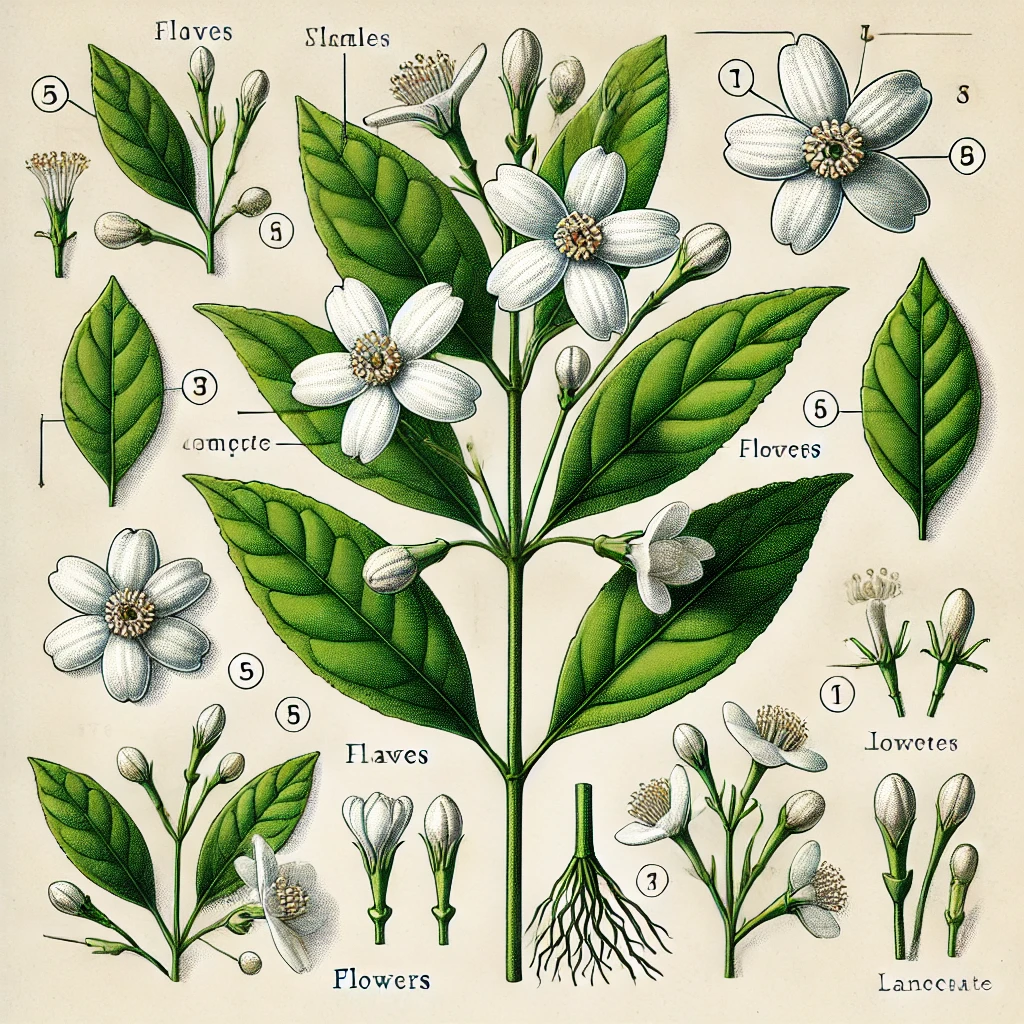
Jui (Jasmine) plants, like many others, are susceptible to various insects and pests that can damage the plant, affecting its growth and flower production. Below is an overview of the common pests that attack the Jui (Jasmine) plant, their life cycles, and how they cause damage.
1. Common Insects and Pests of Jui (Jasmine)
| Pest | Type | Stage of Life Cycle | Damage to Jui Plant |
|---|---|---|---|
| Aphids | Small, soft-bodied insects | Egg → Nymph → Adult | Suck plant sap, causing yellowing leaves and stunted growth. |
| Whiteflies | Tiny, white-winged insects | Egg → Nymph → Adult | Suck plant sap, excrete honeydew, leading to mold growth. |
| Mealybugs | White, cotton-like insects | Egg → Nymph → Adult | Suck sap, causing leaf yellowing, wilting, and dropping. |
| Spider Mites | Tiny, red or brown mites | Egg → Larva → Nymph → Adult | Pierce plant cells, causing leaf discoloration and webbing. |
| Thrips | Small, slender insects | Egg → Nymph → Adult | Feed on flowers and leaves, causing distortion and discoloration. |
| Jasmine Budworm | Caterpillar | Egg → Larva → Pupa → Adult (moth) | Bore into flower buds, preventing flowering and causing bud drop. |
| Scale Insects | Hard-bodied, immobile insects | Egg → Nymph → Adult | Attach to stems and leaves, sucking sap and weakening the plant. |
| Leaf Webber (Caterpillar) | Caterpillar | Egg → Larva → Pupa → Adult (moth) | Webs leaves together, feeding inside and causing leaf damage. |
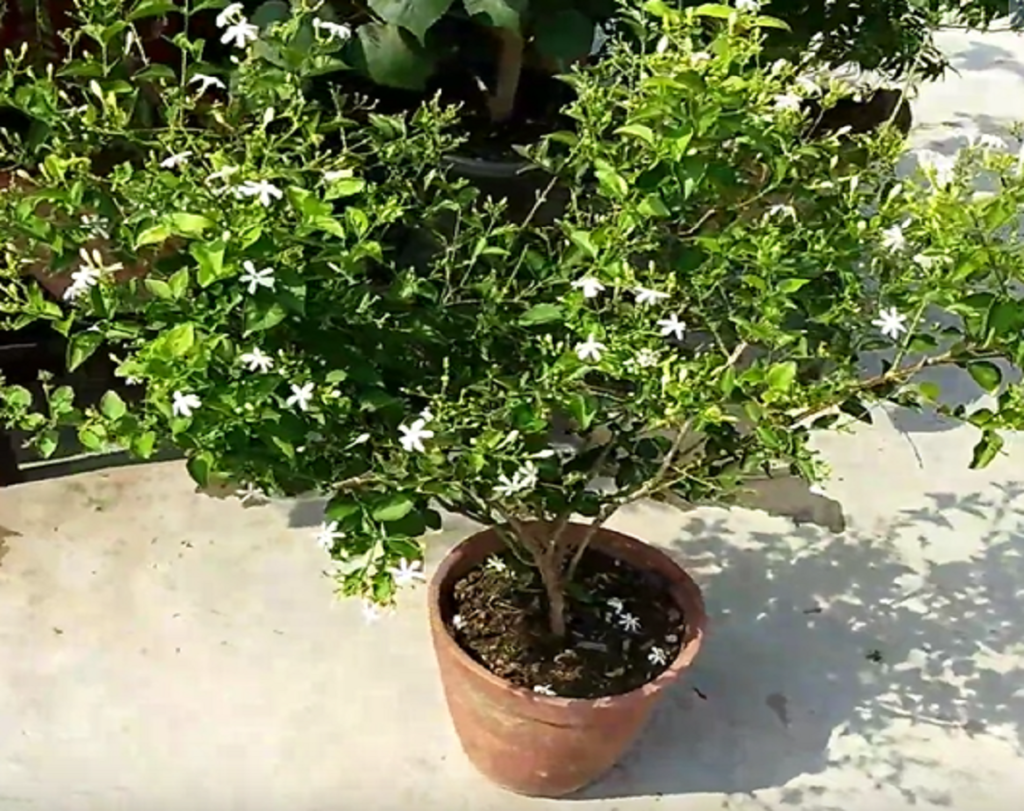
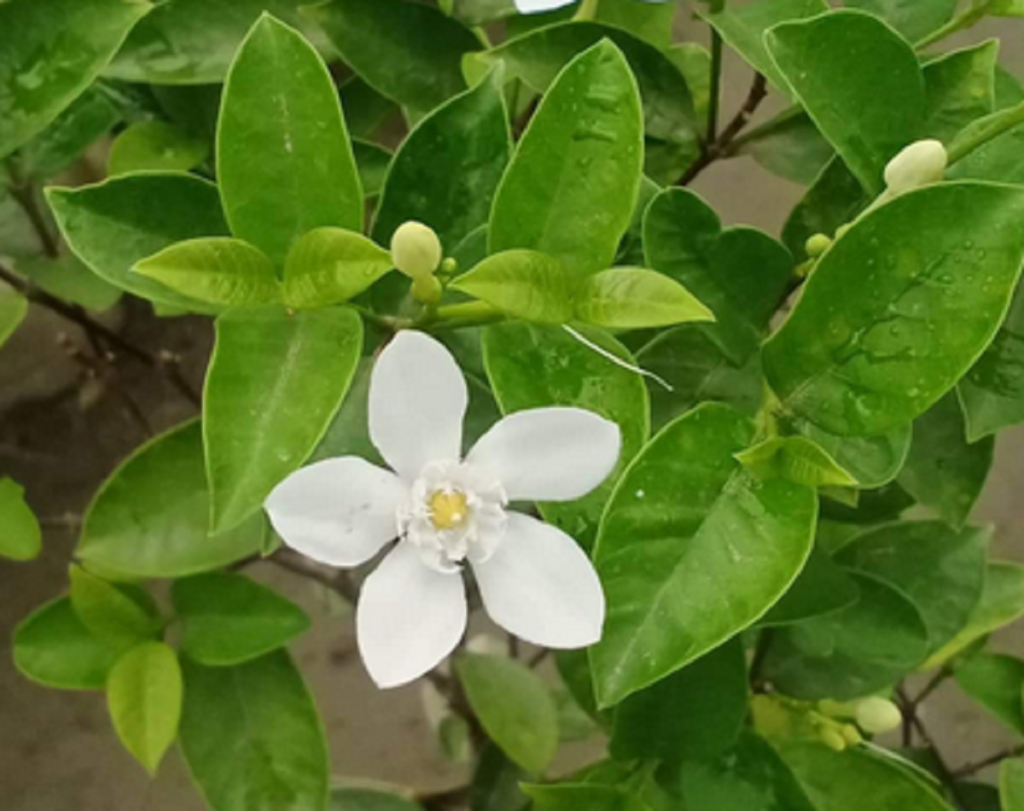
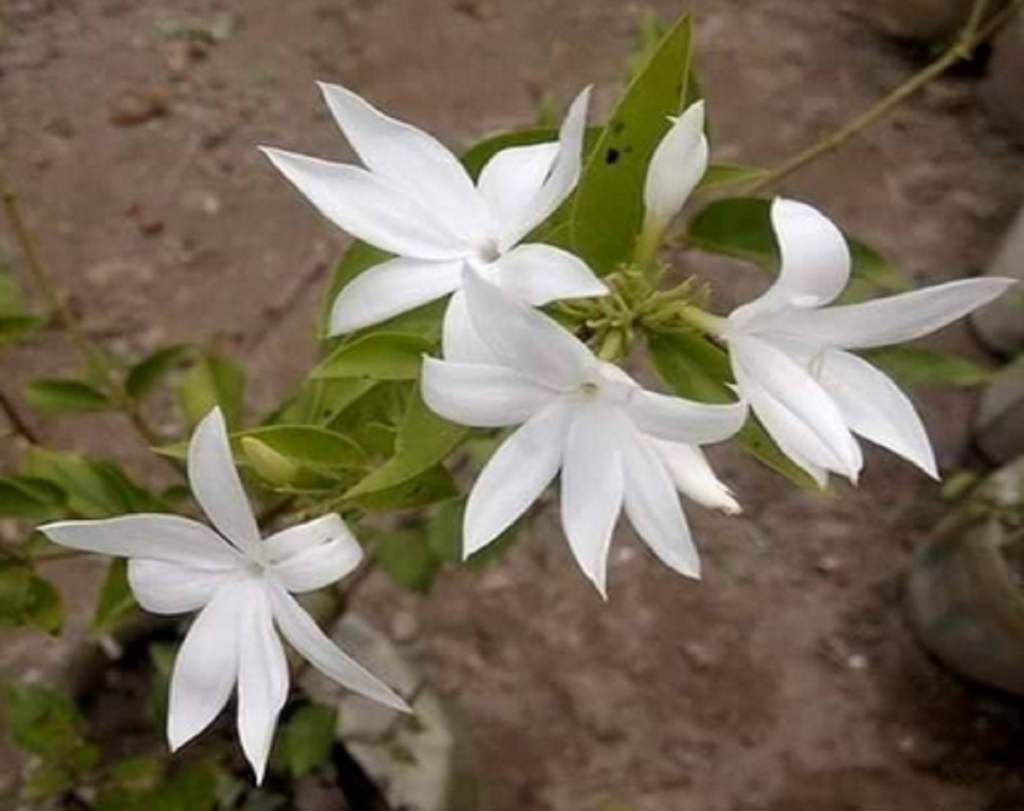
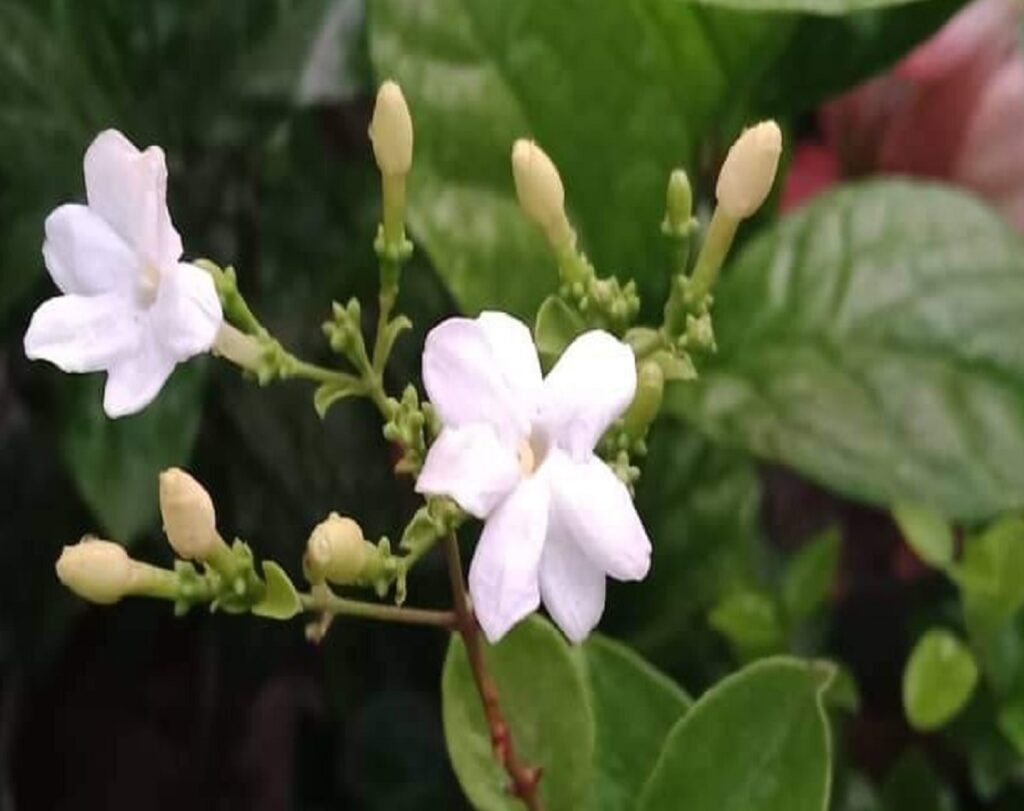
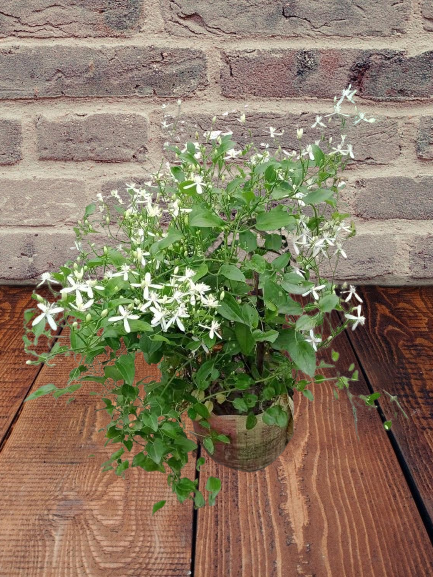
2. Detailed Life Cycles and Attack Patterns
Aphids
- Life Cycle:
- Egg: Laid on leaves or in soil; eggs hatch in favorable conditions.
- Nymph: Nymphs resemble small adults and go through several molts.
- Adult: Mature aphids are winged or wingless and reproduce rapidly.
- Attack:
- Aphids attack by sucking sap from young leaves and flower buds, weakening the plant. This results in curled or yellow leaves and stunted growth. They also secrete honeydew, which attracts ants and promotes mold growth.
Whiteflies
- Life Cycle:
- Egg: Laid on the undersides of leaves.
- Nymph: Goes through 4 instar stages, during which they feed on plant sap.
- Adult: Small, white-winged insects that continue to feed and reproduce.
- Attack:
- Whiteflies suck the sap from leaves, causing yellowing and wilting. Heavy infestations lead to premature leaf drop. Their honeydew secretion fosters sooty mold growth.
Mealybugs
- Life Cycle:
- Egg: Laid in clusters covered in waxy cotton-like filaments.
- Nymph: Resembles adults but smaller; feeds on sap.
- Adult: Soft-bodied insects covered in a waxy, cotton-like secretion.
- Attack:
- Mealybugs pierce plant tissues and suck sap, leading to yellow leaves, wilting, and poor plant growth. Infested plants may develop black sooty mold from the honeydew secretion.
Spider Mites
- Life Cycle:
- Egg: Laid on the underside of leaves.
- Larva: Hatch and begin feeding immediately.
- Nymph/Adult: Nymphs molt several times before becoming adults.
- Attack:
- Spider mites feed on plant cells, leaving tiny yellow or brown spots. A severe infestation causes leaves to become stippled and discolored, with fine webbing appearing between the leaves.
Thrips
- Life Cycle:
- Egg: Inserted into plant tissue.
- Nymph: Small, wingless, and feeds on plant cells.
- Adult: Slender, with fringed wings, and continues to feed on plants.
- Attack:
- Thrips attack leaves and flowers, sucking out sap and leaving silvery streaks. This leads to distortion and discoloration, particularly on flowers, reducing their aesthetic value.
Jasmine Budworm
- Life Cycle:
- Egg: Laid on flower buds.
- Larva (Caterpillar): The larva bores into the buds, feeding internally.
- Pupa: Pupates in the soil or on the plant.
- Adult: Emerges as a moth.
- Attack:
- The larva of the budworm destroys flower buds by boring into them. This results in bud drop and prevents the plant from flowering properly.
Scale Insects
- Life Cycle:
- Egg: Laid under protective scales attached to plant surfaces.
- Nymph: Mobile in the early stages, then settles and becomes immobile.
- Adult: Hard-bodied and immobile, attached to stems or leaves.
- Attack:
- Scale insects feed on plant sap, causing the plant to weaken. Infested plants show yellowing, stunted growth, and leaf drop.
Leaf Webber (Caterpillar)
- Life Cycle:
- Egg: Laid on leaves.
- Larva (Caterpillar): Feeds inside leaves, webbing them together.
- Pupa: Pupates inside the webbed leaves.
- Adult: Emerges as a moth.
- Attack:
- The caterpillars of the leaf webber feed on the inner parts of leaves by webbing them together. This feeding behavior leads to leaf skeletonization and reduced photosynthesis.
3. Integrated Pest Management (IPM)
- Cultural Control: Regular inspection of plants for early signs of infestation, proper spacing for air circulation, and avoiding over-fertilization.
- Biological Control: Introduce beneficial insects such as ladybugs (for aphids) and predatory mites (for spider mites).
- Chemical Control: Use insecticidal soaps, neem oil, or specific pesticides for severe infestations. It’s essential to follow the instructions to minimize harm to beneficial insects.
- Mechanical Control: Prune affected parts, handpick pests, or use water sprays to dislodge pests like aphids and spider mites.


